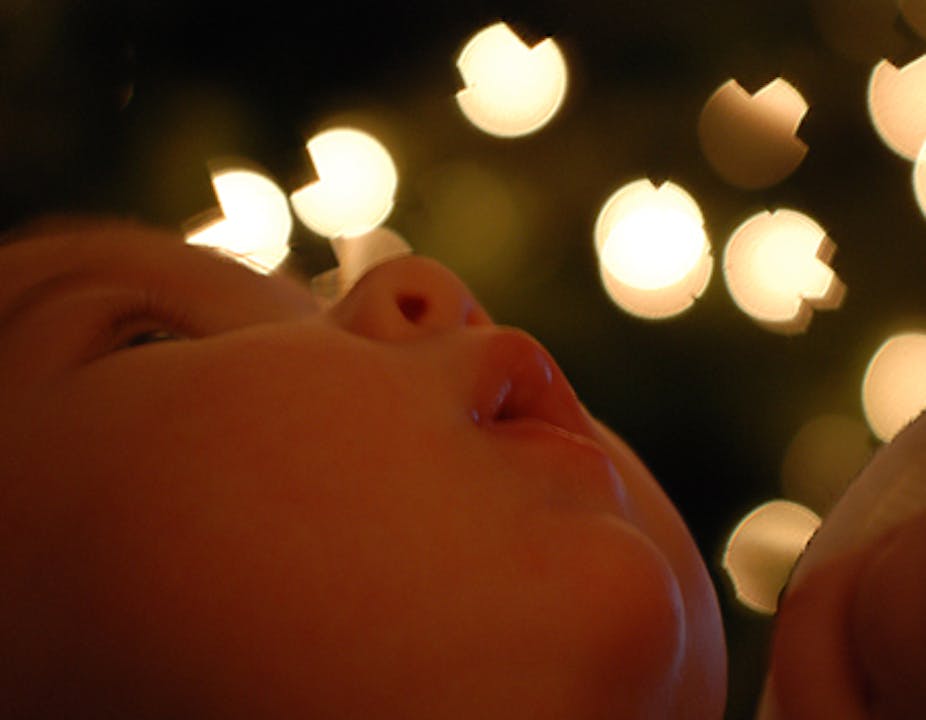What do newborn babies, children who have been severely deprived of human contact, people with autism, and blind mothers have in common? On the surface, not much. But they provide a common theme for understanding how social and communication skills develop in early life.
We are born with basic visual biases, which make us look at faces, as if by reflex (nature). By regularly looking at a parent who talks, smiles, and looks back affectionately at us, we come to understand more about each of these things (nurture). Through this combination of brain-wiring and early experiences, we are set up to become the adults we will be.
Babies notice human faces and want to look at them. They recognise human voices and want to listen. As they experience their parents’ faces and voices, they also begin to understand more complex social signals – where parents are looking, what emotions they are feeling, what they are saying.
Developmental difference and disability
Babies born blind are at an early disadvantage. They miss out on the experiences of eye contact, facial expressions and gestures. But, they can hear their parent’s voice and feel touch so they still learn social information.
Many aspects of blind children’s development are delayed. They tend to learn social and communication skills in different ways. Their parents adapt, using more voice and touch, so the outcome is usually good.
Children who experience extreme early social deprivation are also disadvantaged. Growing up in a crowded orphanage or with severe neglect and abuse leads to developmental delays and, potentially, lifelong disability. These children can see and hear, but they don’t have a carer who gives loving, one-on-one attention.
Clearly, it’s not enough to be born with all one’s senses, early interaction experiences are also critical.
Another important condition to consider here is autism. Children and adults with autism have social and communication difficulties, including problems with eye contact and following where others are looking and pointing.
The problem is not a sensory one. Nor is it because of a lack of loving, attentive parents. Autism is rarely diagnosed before children are two, so we don’t completely understand its early development. But something must be preventing these babies from learning through early visual interaction.
Last year, my colleagues and I made an interesting new finding about early development in autism. We showed a group of seven-month-olds a video of an adult who looked toward them, then away, and back again, and we measured their brain responses.
We found that the brains of babies who did not subsequently develop autism responded differently depending on whether the adult shifted gaze to look toward them or away from them. The brains of babies who developed autism didn’t seem to notice any difference. So, well before a baby could be diagnosed with autism, their brains seemed to be handling socially-relevant visual information in a different way.
Recent research from another group suggests that one early-intervention model for children with autism may work by changing their brain functioning, setting them back on a more optimistic pathway.
Infants of blind parents
Last week, my colleagues and I reported on a new study, in which we followed the development of five children born to blind mothers. The children themselves could see but were being raised by a primary caregiver who couldn’t see them.
Even though the blind mothers would not have been able to respond to what their children were looking at or doing in the usual way, this didn’t seem to put the infants at a disadvantage. They were equally interested in faces and as good at following people’s eye gaze as infants of sighted parents. They were also as good at using eye contact and other social skills with sighted adults as children with parents who could see.
But there were some interesting differences. At seven months, these babies tended to use less eye contact with their blind mothers, and by 14 months, they used more sounds and words. They also had better general learning skills than expected, at seven months and again after two years.
Similarly to babies learning two languages, these infants seemed to become “visual bilinguals”. Rather than putting them at social disadvantage, growing up with a blind mother seemed to have some positive side effects. The infants became more flexible communicators and had enhanced learning skills compared to their peers.
What we are learning
We can discover important information about human development by comparing different groups – what “usually” happens and what changes when nature or nurture deviate from that “usual”. Research like this shows us how remarkably adaptable humans are and how changeable our brains are.
While most of us seem well set up for a good start to social life, our experiences really do shape us. In extreme cases, different life experiences may put us at increased risk – as in situations of neglect and abuse. But in other cases, different experiences may give us an edge.
For developmental scientists like myself, it’s surprising and exciting to see that when humans are challenged, even as very young babies, we really can rise above and excel.

